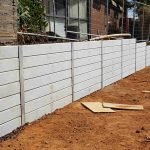Introduction
Building a retaining wall is no small feat, and it often involves a myriad of factors to consider-- chief among them being licenses and policies. Whether you're selecting timber sleeper walls, concrete sleeper alternatives, and even H beam structures, understanding the legal landscape is important. This post aims to assist you through the complex world of permit requirements when dealing with your retaining wall contractor.
Navigating Authorization Requirements with Your Retaining Wall Contractor
When you're all set to transform your outside area with a retaining wall, it's natural to feel enjoyment. Nevertheless, before the very first shovel hits the ground, there are numerous license requirements you need to browse. Getting these authorizations isn't simply a governmental obstacle; it's necessary for guaranteeing security and compliance with regional laws.
Why Are Allows Necessary?
Permits serve several functions:
Safety: They make sure that structures are built to hold up against ecological stresses. Compliance: They make certain that your building abides by local structure codes. Protection: They protect residential or commercial property values in your area by making sure that all building fulfills recognized standards.
Types of Keeping Walls
Before diving into licenses, let's briefly overview the kinds of retaining walls you'll normally come across:
- Timber Sleeper Walls: These are often used for smaller tasks due to their aesthetic appeal and lower cost. Concrete Sleeper Walls: More resilient than lumber, these walls can manage much heavier loads but might need more comprehensive permitting. H Beam Structures: These are normally utilized for bigger business tasks due to their strength however featured their own set of allowing challenges.
Understanding Regional Regulations
Researching Local Codes
Every locality has its own set of building codes and regulations. It's necessary to familiarize yourself with these:
- Start by visiting your local zoning office. Many towns have online resources where you can look up residential structure codes.
Common Permit Types
Here are some typical authorizations you might need:
Building Permit: Needed for many structural changes. Zoning Permit: Makes sure that your task is compliant with land usage laws. Environmental Permits: Essential if your project affects wetlands or other safeguarded areas. https://reidcontractormuih651.bravesites.com/entries/general/What-Sets-Top-Tier-Retaining-Wall-Installers-Apart-Choosing the Right Contractor
Experience Matters
When selecting a contractor for your retaining wall project, consider their experience level:
- Look for professionals who concentrate on keeping walls. Ask about previous projects comparable to yours.
Questions to Ask Potential Contractors
What types of products do you deal with (e.g., timber sleeper, concrete sleeper)? Are you acquainted with local authorization requirements? Can you offer recommendations from previous clients?The Value of Professional Guidance
Consulting Experts
Having a professional contractor at hand can conserve you time and headaches down the line:
- They often have actually developed relationships with local authorities. They comprehend which permits are required for different types of walls.
Benefits of Employing Professionals
Expertise in browsing complicated regulations. Ability to recognize prospective concerns before they arise. Knowledge about affordable products and methods.Steps in Getting Permits
1. Preliminary Research
Before looking for any licenses:
- Assess whether your job needs a simple or intricate application process based upon its scope and location.
2. Total Your Application
Gather all needed details for your application:
- Project plans Site surveys Material lists (consisting of timber sleeper and concrete sleeper requirements)
3. Send Your Application
Once you have actually collected whatever:
- Submit your application to the appropriate municipal office.
4. Wait for Approval
Permitting procedures can take time; patience is key:
- Be got ready for possible revisions if officials request changes.
Potential Obstacles in Getting Permits
1. Regional Ordinances
Local ordinances might impose limitations on wall height or product usage-- be thorough in inspecting these!
2. Ecological Concerns
If you're near water bodies or protected lands, extra examination will be used:
- You might need extra ecological assessments.
FAQs About Retaining Wall Permits
1. Do I always need a permit for a maintaining wall?
Yes, unless it's very little or does not satisfy specific height requirements specified by local regulations.
2. For how long does it take to get a permit?
Typically between 2 weeks to numerous months depending on the complexity of the job and local processing times.

3. Can my contractor assist me get permits?
Absolutely! A professional contractor typically has experience navigating the permitting process effectively.
4. What takes place if I build without a permit?
You could face fines and be required to take apart any unapproved structures.
5. Exist particular materials that require different permits?
Yes, specific products like concrete sleepers may need additional documents compared to simpler materials like timber sleepers.
6. How can I expedite the allowing process?
Ensure all documentation is complete and accurate before submission; work closely with an experienced contractor who knows what local authorities look for!
Conclusion
As we have actually described in this guide on "Navigating License Requirements with Your Retaining Wall Contractor," getting the right permits is essential when preparing any retaining wall job-- be it using timber sleepers, concrete sleepers, or H beam structures. With appropriate planning, research study, and consultation from professionals well-acquainted with local guidelines, you can improve this difficult process while guaranteeing security and compliance at every step along the way.
By following these guidelines diligently, you'll not just secure needed approvals but also pave the way towards creating an excellent function that improves both visual appeals and performance in your outside space!